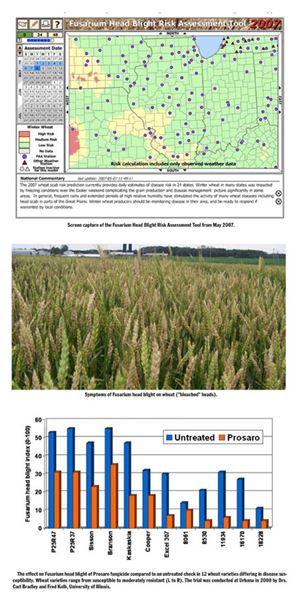Management Of Fusarium Head Blight (Scab Of Wheat)
Fusarium head blight (aka scab) can be one
of the most devastating diseases of wheat
when conditions are favorable for it. Scab
can cause both yield and quality losses. Quality
losses can be due to lower test weights and contamination
of grain by toxins (i.e., deoxynivelanol,
or DON) produced by the fungus that
causes Fusarium head blight; both can be a serious
problem for producers and millers.
Because the fungal pathogen that causes
Fusarium head blight (Fusarium graminearum,
also known as Gibberella zeae) can also affect
corn, causing Gibberella stalk and ear rot, the
pathogen is already present throughout Illinois
in many fields. Weather is generally the driving
factor in the development of Fusarium head
blight. Because wheat is susceptible to the disease
during flowering, the weather conditions
from flowering through kernel development play
a key role in the incidence and severity of scab.
Moderate temperatures (75 to 85°F), prolonged
high humidity, and prolonged wet periods favor
disease development. A disease forecasting system
– the Fusarium Head Blight Risk Assessment
Tool – based on weather conditions is
available online. A "risk map" can be obtained
that shows the risk of Fusarium head blight
throughout Illinois (and other states). This forecasting
system was developed through collaboration
by many university plant pathologists and
funded through the U.S. Wheat and Barley Scab
Initiative.

Symptoms of Fusarium head blight on wheat ("bleached" heads).
The effect on Fusarium head blight of Prosaro fungicide compared
to an untreated check in 12 wheat varieties differing in disease
susceptibility.
Wheat varieties range from susceptible to moderately resistant (L to R).
The trial was conducted at Urbana in 2008 by Drs.
Carl Bradley and Fred Kolb, University of Illinois.
Screen capture of the Fusarium Head Blight Risk Assessment Tool from May 2007.
By the time symptoms of Fusarium head blight
appear on wheat heads, which can be observed
as "bleached" heads or heads with both green
and bleached areas, it is too late to manage the
disease. Successful scab management requires
an integrated approach and begins prior to
planting when producers decide which varieties
to plant and which fields to plant into wheat.
Resistant varieties. Although no wheat varieties
are immune to Fusarium head blight, some
are more resistant than others. Dr. Fred Kolb's
wheat-breeding program at the University of Illinois
has rated varieties for Fusarium head blight
severity under high-pressure environments over
multiple years. These ratings are available online
at the University of Illinois Variety Testing
site, in the "Small Grains" section.
Cropping sequence. Because corn stubble can
harbor the Fusarium head blight pathogen,
wheat following soybean is at a lower risk of developing
the disease than wheat following corn.
Foliar fungicides. The use of foliar fungicides
is the only "in-season" option for control of
Fusarium head blight. Although fungicides are
a good control option, losses will still occur on a
highly susceptible variety sprayed with a fungicide
in an environment favorable for disease. A
University of Illinois field research trial conducted
at Urbana in 2008 evaluated the effect of
fungicides on 12 different wheat varieties that
ranged from susceptible to moderately resistant
to Fusarium head blight. In this trial, the best
control was achieved when resistant varieties received
fungicide applications. On susceptible varieties,
Fusarium head blight levels were still as
high as 35% even after a fungicide was applied.
It is important to note that this trial had very
high disease pressure – it was inoculated with
the Fusarium head blight pathogen and the trial
was mist-irrigated to provide a very favorable environment
for disease.
Timing of fungicide application is very important
to get the best control. Fungicides should
be applied at Feekes growth stage 10.5.1 (early
anthesis, when the anthers are just beginning to
extrude from the head). It is also important to
spray with nozzles oriented to spray forward,
which helps improve fungicide coverage of the
wheat head.
Due to several fungicide registrations after the
2008 season, 2009 is the first time Illinois growers
have several effective fungicide products
available for control of Fusarium head blight.
The North Central Regional Committee on Management
of Small Grain Diseases (NCERA-184)
has developed a fungicide efficacy table for
wheat diseases (Adobe PDF, 80kb). Based on
multistate and multiyear data, this table rates
the effectiveness of the available fungicide products
for control of Fusarium head blight and
other diseases. It is important to note that only
a few fungicides have Fusarium head blight
listed on their labels, and these are only triazole
fungicides (Prosaro, Caramba, Folicur, and a few
others). Products that contain a strobilurin fungicide
(Headline, Quilt, TwinLine, Stratego, and
others) can be applied earlier in the season to
help protect against foliar diseases, but they
should never be applied when heads are present.
In some instances, strobilurin fungicides
applied later in the season can cause an increase
in DON toxin contamination in grain, so it is important
to never apply strobilurin fungicides at
the later growth stages. Δ
DR. CARL A. BRADLEY: Assistant Professor
Crop Production, Integrated Pest Management,
Plant Pathology, University of Illinois